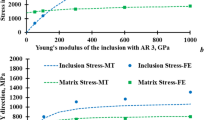Abstract
Two-parameter methods of fracture analysis for determining the stress-intensity factor from photoelastic isochromatic-fringe data were critically reviewed. The methods of Irwin, Bradley and Kobayashi, and Smith were developed in detail and differences in the three approaches were noted. Theoretical fringe loops were generated for a crack of length 2a in a semi-infinite plate with biaxial loading. These fringe loops were used to compare the three analysis methods and to determine the accuracy of each method.
All three methods give a close estimate of the stress-intensity factor, with the Bradley-Kobayashi differencing procedure providing the most precise estimate ofK. However, if measurement errors become excessive (larger than 2 percent) the differencing procedure magnifies these errors and the original method proposed by Irwin is the recommended approach.
The two-parameter methods can be employed to determineK to within ±5 percent, provided the angle of tilt of the isochromatic-fringe loop is 73 ≤θ m < 139 deg. Ifθ m is outside this range, the two-parameter methods should not be employed.
Similar content being viewed by others
References
Post, D., “Photoelastic Stress Analysis for an Edge Crack in a Tensile field,”Proc. of SESA,12 (1),99–116 (1954).
Wells, A. andPost, D., “The Dynamic Stress Distribution Surrounding a Running Crack—A Photoelastic Analysis,”Proc. of SESA,16 (1),69–92 (1958).
Irwin, G.R., Disc. of Ref. 2, Proc. of SESA,16 (1),93–96 (1958).
Bradley, W.B., “A Photoelastic Investigation of Dynamic Brittle Fracture,” PhD Thesis, Univ. of Washington (1969).
Schroedl, M.A. and Smith, C.W., “Local Stress Near Deep Surface Flaws Under Cylindrical Bonding Fields,” Progress in Flaw Growth and Fracture Toughness Testing, ASTM STP 536, ATM, 45–63 (1973).
Irwin, G.R., “Analysis of Stresses and Strains Near the End of a Crack Traversing a Plate”J. Appl. Mech.,24 (3) (Sept. 1957).
Bradley, W.B. andKobayashi, A.S., “An Investigation of Propagating Cracks by Dynamic Photoelasticity,”Experimental Mechanics,10 (3),106–113 (March1970).
Kobayashi, A.S., Wade, B.G. andBradley, W.B., “Fracture Dynamics of Homalite-100,”Deformation and Fracture of High Polymers, Kausch, H.H., Haseell, J.A., Jaffee, R.I., eds., Plenum Press, New York, 487–500 (1973).
Kobayashi, A.S., Mall, S. and Lee, M.H., “Fracture Dynamics of Wedge-Loaded DCB Specimen,” presented at ASTM Meeting, August 1975, Pittsburgh, PA, to be published.
Schroedl, M.A., McGowen, J.J. andSmith, C.W., “An Assessment of Factors Influencing Data Obtained by the Photoelastic Stress Freezing Technique for Stress Fields Near Crack Tips,”VPI-E-72.6, J. of Engrg. Fract. Mech.,4 (4)801–809 (Dec.1972).
Author information
Authors and Affiliations
Additional information
This research represents partial fulfillment of the requirements for a PhD degree at the University of Maryland.
Rights and permissions
About this article
Cite this article
Etheridge, J.M., Dally, J.W. A critical review of methods for determining stress-intensity factors from isochromatic fringes. Experimental Mechanics 17, 248–254 (1977). https://doi.org/10.1007/BF02324838
Received:
Revised:
Issue Date:
DOI: https://doi.org/10.1007/BF02324838




